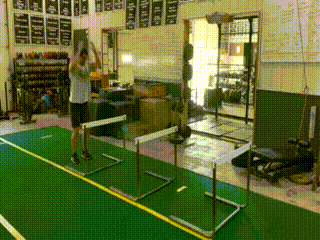Hurdle Hop
Master the Hurdle Hop: Techniques and Benefits for Improved Performance
Athletes need to be fast, strong, and explosive. In all sports, the attributes of speed, strength, and explosiveness contribute to being a better athlete, an elite athlete.
One of the greatest implements for improving overall athleticism, particularly speed and explosiveness, is the hurdle. High hurdles and mini hurdles come in heights as low as 6” and typically up to heights of 42”, though some athletes, namely high jumpers and very capable leapers, use hurdles of even higher heights.
The hurdle is typically associated with the track sprinting events, like the 110-meter hurdle race. Or maybe the steeple chase is a more appropriate hurdle? All kidding aside, there is a lot more that can be done with the implementation of the hurdle hop than bounding over them in a race.
Let’s jump in (pun intended) and take a gander at how best to utilize the hurdle hop as a means to become a better athlete to develop speed, namely in the form of acceleration, explosiveness, namely in the realm of power, and strength.

Plyometrics
Plyometrics in the most simplest set is a fancy way of saying jumping.
At a more complicated level, plyometrics are the implementation of specific jumping protocols to increase explosiveness, speed, strength, and power within athletes for superior performance in competitive play.
Training with plyometrics is intense training. Jumping in general is an intensive movement. Yes, the load is nothing more than bodyweight (typically), but the effort is incredibly fast and almost always performed at a near max effort attempt during execution; it is kind of hard to not jump and get your heart rate up, muscles firing, and muscle hypertrophy occurring.
Look at a plyometric movement like jumping rope. Jumping rope is more of an endurance type of workout. Because the jumping part of the jump rope movement, the plyometric movement, is so intense, it is near impossible to jump rope at a low heart rate, or what is typically seen as staying in zone 2. Point being is that jumping is intense.
Continuing to use the jump rope as an example, look at the hypertrophy that takes place from leaping repeatedly? The calves and tibialis muscles feel the pump, get swole, and will have hypertrophy from the plyometric exercise.
But neither endurance nor hypertrophy are the main focus of plyometrics. The main focus of plyometrics is explosiveness and speed.
The explosiveness is latent in jumping. Max vertical jump, max broad jump, or a high jump attempt are great tests for explosiveness. Plyometrics is explosive training.
That leaves speed. Think of speed in three ways: top end speed, change of direction, and acceleration. Plyometrics helps a bit with top end speed, but not as much as sprinting. But plyometrics do help tremendously with acceleration and change of direction, especially if jump series are used.
Acceleration in regard to speed is synonymous with explosiveness. Change of direction in regard to speed is putting on the brakes and getting going again (another version of acceleration). No matter how it is thought about, plyometrics help here.
And one of the best implements to use for performing plyometrics is hurdle hops.

Hurdle Hop
The hurdle hop is as simple as jumping over an object and landing on the other side. The jump can be performed on one leg, two legs, straight ahead, laterally, or a combination of all the above.
Hurdle hops are like a box jump with a depth jump put together. A box jump has an athlete jump a certain height and land at that same height. A depth drop has athletes stepping from a height and landing. Both are pretty typical plyometric exercises.
With the hurdle hop, athletes have to jump a certain height and then land back on the ground. Usually, hurdles are put one after the other to create a series of jumps. Athletes need to jump, land, jump, land, and jump and land again, depending on the number of hurdles set up to leap over.
The easiest way to perform a hurdle hop is putting the hurdle right in front of the athlete. The athlete then jumps over the hurdle. The hurdle hop is similar to a tuck jump, except there is an implement, the hurdle, to ensure the intent is at a certain level based on the height.
Besides jumping bilaterally over the hurdle directly in front, athletes can also jump laterally bilaterally. Jumping laterally can also be done off one foot. In this way, the one-foot jump mimics the force of cutting during an open skill athletic event.
Single leg hurdle hops benefit from using mini hurdles. The mini hurdle helps maintain intent, but also doesn’t put the height so high that the task feels unachievable.

Hurdle Hop Technique
The hurdle hop technique is very similar to most plyometric exercises. The start is essentially the same as a box jump.
The jump, like almost all jumps (except seated jumps) starts with a counter movement. The counter movement is basically a quarter squat. During the quarter squat, the arms swing back and the trunk stays controlled.
The counter movement completed, the arms swing up and forward, the chest rises, and the muscles in the legs explode with twitchy force to leap over the hurdle.
If this was a box, the only thing left to do would be landing on the box. But this is a hurdle being jumped over, not on.
Like most jumps over or onto an object, the knees are tucked up. The knees being tucked up helps clear the implement. It is also a sign of mobility, core strength, and athleticism.
So, unlike the box jump, the hurdle hop requires a landing. The landing needs to be elastic. The ankles, knees, and hips need to be rigid, but flexible. There needs to be some give to load the muscles up, but not so stiff that there is no stretch shortening taking place. Also, athletes can’t be so loose that they sink into the bottom of a squat.
The landing of the hurdle hop is so important because hurdle hops are rarely done as one jump. Hurdle hops are typically done in a series of two to six hurdles. Ideally, the jumps are done rapid fire, one after the other.
However, there are great ways to build the rapid-fire style hurdle hop. One of the best ways to build into the rapid-fire style is using the stutter jump. Between each hurdle hop, take a mini jump. The mini jump allows athletes to regain the elasticity that may be lost from the depth drop part of the hurdle hop.
And that’s it. Jump over the hurdle, land, be elastic, jump again, and land. Be sure to keep the height manageable to begin and build over the course of months to higher and higher hurdles. Ensuring that athletes maintain elasticity in their jumps no matter the height of the hurdle.

Hurdle Hop Benefits
Like all plyometrics, the hurdle hop brings great benefit to athletes who are trying to get an intense workout, develop explosiveness, and improve their acceleration capabilities in regard to speed.
Hurdle hop benefits include being able to improve jumping capabilities, vertical jump height, and the ability to change direction–think about landing from a hurdle hop and rebounding into another leap.
The ability to absorb the depth drop portion of the hurdle hop and reapply force is great for athletes. The needed force to be elastic, take the stretch shortening cycle, and reapply force to generate high levels of impulse to power against gravity and sky over a hurdle within the series is a recipe for speed, agility, and power.
In addition to all the acceleration, deceleration, and change of direction speed capabilities, the hurdle hop plyometric also does wonders for athlete explosiveness. Athletes who are explosive appear twitchy–they move fast. The twitchiness creates the ability to generate high levels of impulse in a short amount of time to be as powerful as possible.
Sample Athlete Day Workout (Hurdle Hop Focus)


The Bottom Line
The hurdle hop is a great plyometric exercise for athletes to utilize on an athlete day (or even as part of contrast training for the lower body) to help develop acceleration, explosiveness, and power. Athletes of all varieties, closed skilled and open skilled sport athletes, can benefit greatly from utilizing hurdle hops in their training. Whether needing to make a cut to change direction on the field, cross up a defender on the court, launch a shot put from the shoulder, win a track race, or have a strong, powerful dip in a jerk, the hurdle hop may be the best plyometric movement to utilize.
So, if you’re an athlete looking to up their athleticism, become more explosive, or improve acceleration capabilities, head over to peakstrength.app and download Peak Strength our strength training app developed with athletes in mind so you can reap the benefits of athlete day and all the various plyometric exercises that will make you more elastic, more explosive, and better able to perform in competition.
Later.


EARL KUNKEL
3x World Champion Co-Author of the Year
King of the PA Press
Blog Topics

Yo, It's Dane
Welcome to the Garage Strength Blog, where it is my goal to provide you with the experience and knowledge I've gained in the strength and conditioning world over many years of learning from both successes and failures. I train elite-level athletes in a multitude of sports from the high school to professional levels, already producing 5 Olympics and 30+ National Champions. If you want to be the next champion I train, check out my strength programs below!
Start Training With Me

Join for free educational videos EVERY WEEK on strength coaching and athletic performance

